Articles
- Page Path
- HOME > Korean J Community Nutr > Volume 19(2); 2014 > Article
-
Research Article
- Dietary Intake Status among Korean Female Breast Cancer Survivors
- Myungsook Park, Eunkyung Hwang, Hyeong-Gon Moon, Dong-Young Noh, Jung Eun Lee
-
Korean Journal of Community Nutrition 2014;19(2):163-175.
DOI: https://doi.org/10.5720/kjcn.2014.19.2.163
Published online: April 30, 2014
1Department of Food and Nutrition, Sookmyung Women's University, Seoul, Korea.
2Breast Care Center, Seoul National University Hospital, Seoul, Korea.
3Department of Surgery and Cancer Research Institute, Seoul National University College of Medicine, Seoul, Korea.
- Corresponding author: Jung Eun Lee. Sookmyung Women's University, Cheongpa-ro, 47-gil 100, Yongsan-gu, Seoul 140-742, Republic of Korea. Tel: (02) 2077-7560, Fax: (02) 710-9479, junglee@sm.ac.kr
Copyright © 2014 The Korean Society of Community Nutrition
This is an Open-Access article distributed under the terms of the Creative Commons Attribution Non-Commercial License (http://creativecommons.org/licenses/by-nc/3.0/) which permits unrestricted non-commercial use, distribution, and reproduction in any medium, provided the original work is properly cited.
- 1,235 Views
- 6 Download
- 6 Crossref
Figure & Data
REFERENCES
Citations

- Utilization of Nutrition Labels and Its Relation to Nutrient Intake among Cancer Survivors: The 2019–2021 Korea National Health and Nutrition Examination Survey
Kyujin Choi, Seyoung Son, Hee-Kyung Joh, Su-Min Jeong
Korean Journal of Family Practice.2023; 13(4): 225. CrossRef - Nutrient intakes from supplement and factors associated with supplement use among breast cancer survivors: A cross‐sectional study
Jiyoung Youn, Sihyun Park, Sihan Song, Hyeong‐Gon Moon, Dong‐Young Noh, So‐Youn Jung, Eunsook Lee, Zisun Kim, Hyun Jo Youn, Jihyoung Cho, Young Bum Yoo, Se Kyung Lee, Taisun Hyun, Jung Eun Lee
European Journal of Cancer Care.2021;[Epub] CrossRef - A Comparisons of Nutritional Intake and Diet Quality Index-International in Gynecological Cancer Survivors and Normal Women: Using the Korea National Health and Nutrition Examination Survey 2013~2016
Bo-Young Seo, Eun-Sil Her
Korean Journal of Community Nutrition.2020; 25(5): 406. CrossRef - The Effects of Utilizing Smartphone Application Peer Support on Health Behavior and Body Mass Index among Breast Cancer Survivors
Gaeun Park, Haejung Lee, Hyun Yul Kim
Journal of Korean Academy of Nursing.2019; 49(5): 550. CrossRef - Determinants of Plasma 25-Hydroxyvitamin D Concentrations among Breast Cancer Survivors in Korea
Woo-Kyoung Shin, Zisun Kim, Hyun Youn, Jihyoung Cho, Jung Lee
Nutrients.2018; 10(3): 380. CrossRef - Development of a FFQ for breast cancer survivors in Korea
Woo-kyoung Shin, Sihan Song, Eunkyung Hwang, Hyeong-Gon Moon, Dong-Young Noh, Jung Eun Lee
British Journal of Nutrition.2016; 116(10): 1781. CrossRef
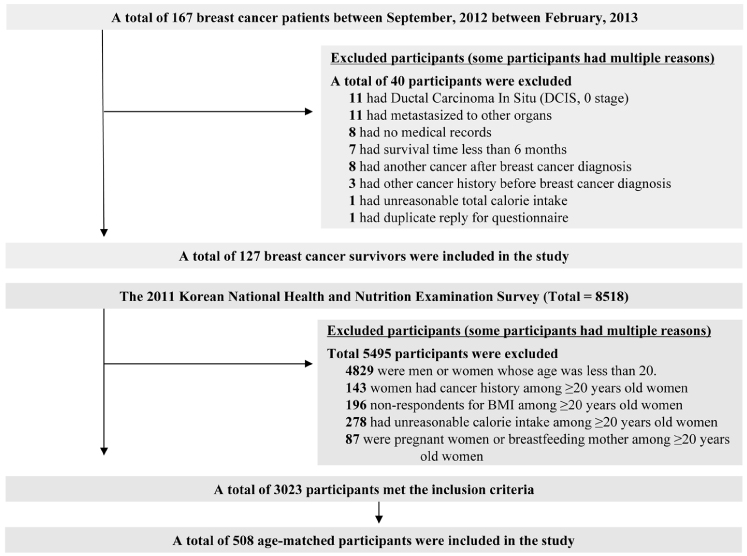
Fig. 1
Clinical characteristics and changes in diet and weight after the breast cancer diagnosis among breast cancer survivors
Abbreviations: SD, standard deviation; ER, estrogen receptor; PR, progesterone receptor; AJCC, American joint committee on cancer.
1) Analyzed 94 cases who changed their diet after the breast cancer diagnosis
2) Analyzed 50 cases because 2 cases did not respond to the question on average weight change
3) Analyzed 33 cases
Nutrient intakes according to time since surgery
Abbreviations: M, month; LS means, least squared means.
Adjusted for age (years, continuous), body mass index (kg/m2, continuous), marital status (married or cohabitation, others), education level (middle school or less, high school or unknown, college or more), dietary supplement use (yes or no), physical activity (MET-hour per week, continuous) and total energy intake (kcal/d, continuous). For energy intake analysis, total energy intake was not adjusted.
Food group intake according to time since surgery
Abbreviations: M, month; LS means, least squared means.
Adjusted for age (years, continuous), body mass index (kg/m2, continuous), marital status (married or cohabitation, others), education level (middle school or less, high school or unknown, college or more), dietary supplement use (yes or no), physical activity (MET-hour per week, continuous) and total energy intake (kcal/d, continuous).
Nutrient intakes according to cancer stage
Abbreviations: LS means, least squared means.
Adjusted for age (years, continuous), body mass index (kg/m2, continuous), marital status (married or cohabitation, others), education level (middle school or less, high school or unknown, college or more), dietary supplement use (yes or no), physical activity (MET-hour per week, continuous) and total energy intake (kcal/d, continuous). For energy intake analysis, total energy intake was not adjusted.
Food group intake according to cancer stage
Abbreviations: LS means, least squared means.
Adjusted for age (years, continuous), body mass index (kg/m2, continuous), marital status (married or cohabitation, others), education level (middle school or less, high school or unknown, college or more), dietary supplement use (yes or no), physical activity (MET-hour per week, continuous) and total energy intake (kcal/d, continuous).
Comparison of socio-demographic factors between breast cancer survivors and age-matched KNHANES population
1)
Comparison of nutrient intake between breast cancer survivors and age-matched KNHANES population
Abbreviation: LS Means, least squared means.
Adjusted for age (years, continuous), body mass index (kg/m2, continuous), marital status (married or cohabitation, separated or widowed, divorced or single, others or unknown), education level (elementary school, middle school, high school or unknown, college or more), equalized household income (low, mid-low, mid-high, high), smoking status (never-, ever-smoker, unknown), menopausal status (pre-, natural-, premature-menopause, unknown), dietary supplement use (yes or no), physical activity (vigorous and moderate, vigorous only, moderate only, no or unknown) and total energy intake (kcal/d, continuous). For energy intake analysis, total energy intake was not adjusted.
Comparison of food group intake between breast cancer survivors and age-matched KNHANES population
Abbreviation: LS Means, least squared means.
Adjusted for age (years, continuous), body mass index (kg/m2, continuous), marital status (married or cohabitation, separated or widowed, divorced or single, others or unknown), education level (elementary school, middle school, high school or unknown, college or more), equalized household income (low, mid-low, mid-high, high), smoking status (never-, ever-smoker, unknown), menopausal status (pre-, natural-, premature-menopause, unknown), dietary supplement use (yes or no), physical activity (vigorous and moderate, vigorous only, moderate only, no or unknown) and total energy intake (kcal/d, continuous). For energy intake analysis, total energy intake was not adjusted.
Abbreviations: SD, standard deviation; ER, estrogen receptor; PR, progesterone receptor; AJCC, American joint committee on cancer. 1) Analyzed 94 cases who changed their diet after the breast cancer diagnosis 2) Analyzed 50 cases because 2 cases did not respond to the question on average weight change 3) Analyzed 33 cases
Abbreviations: M, month; LS means, least squared means. Adjusted for age (years, continuous), body mass index (kg/m2, continuous), marital status (married or cohabitation, others), education level (middle school or less, high school or unknown, college or more), dietary supplement use (yes or no), physical activity (MET-hour per week, continuous) and total energy intake (kcal/d, continuous). For energy intake analysis, total energy intake was not adjusted.
Abbreviations: M, month; LS means, least squared means. Adjusted for age (years, continuous), body mass index (kg/m2, continuous), marital status (married or cohabitation, others), education level (middle school or less, high school or unknown, college or more), dietary supplement use (yes or no), physical activity (MET-hour per week, continuous) and total energy intake (kcal/d, continuous).
Abbreviations: LS means, least squared means. Adjusted for age (years, continuous), body mass index (kg/m2, continuous), marital status (married or cohabitation, others), education level (middle school or less, high school or unknown, college or more), dietary supplement use (yes or no), physical activity (MET-hour per week, continuous) and total energy intake (kcal/d, continuous). For energy intake analysis, total energy intake was not adjusted.
Abbreviations: LS means, least squared means. Adjusted for age (years, continuous), body mass index (kg/m2, continuous), marital status (married or cohabitation, others), education level (middle school or less, high school or unknown, college or more), dietary supplement use (yes or no), physical activity (MET-hour per week, continuous) and total energy intake (kcal/d, continuous).
1)
Abbreviation: LS Means, least squared means. Adjusted for age (years, continuous), body mass index (kg/m2, continuous), marital status (married or cohabitation, separated or widowed, divorced or single, others or unknown), education level (elementary school, middle school, high school or unknown, college or more), equalized household income (low, mid-low, mid-high, high), smoking status (never-, ever-smoker, unknown), menopausal status (pre-, natural-, premature-menopause, unknown), dietary supplement use (yes or no), physical activity (vigorous and moderate, vigorous only, moderate only, no or unknown) and total energy intake (kcal/d, continuous). For energy intake analysis, total energy intake was not adjusted.
Abbreviation: LS Means, least squared means. Adjusted for age (years, continuous), body mass index (kg/m2, continuous), marital status (married or cohabitation, separated or widowed, divorced or single, others or unknown), education level (elementary school, middle school, high school or unknown, college or more), equalized household income (low, mid-low, mid-high, high), smoking status (never-, ever-smoker, unknown), menopausal status (pre-, natural-, premature-menopause, unknown), dietary supplement use (yes or no), physical activity (vigorous and moderate, vigorous only, moderate only, no or unknown) and total energy intake (kcal/d, continuous). For energy intake analysis, total energy intake was not adjusted.

 KSCN
KSCN

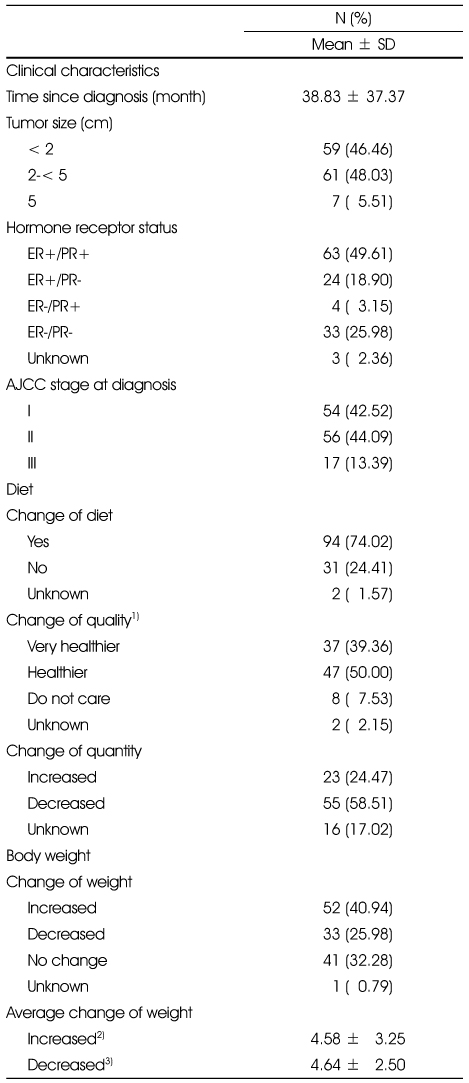
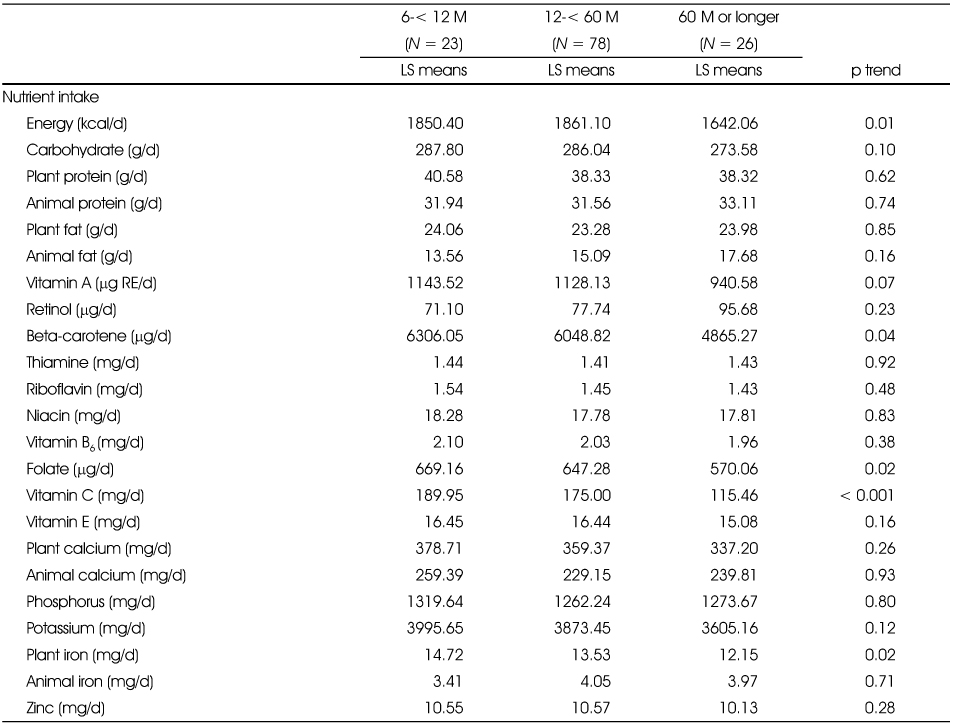
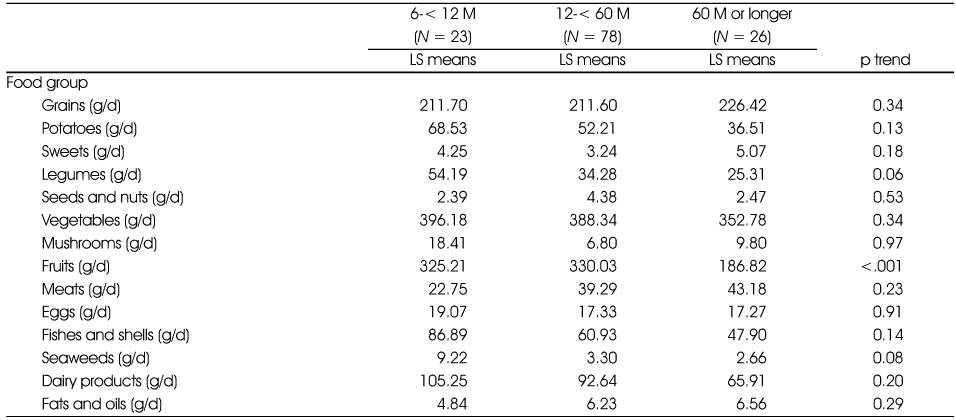
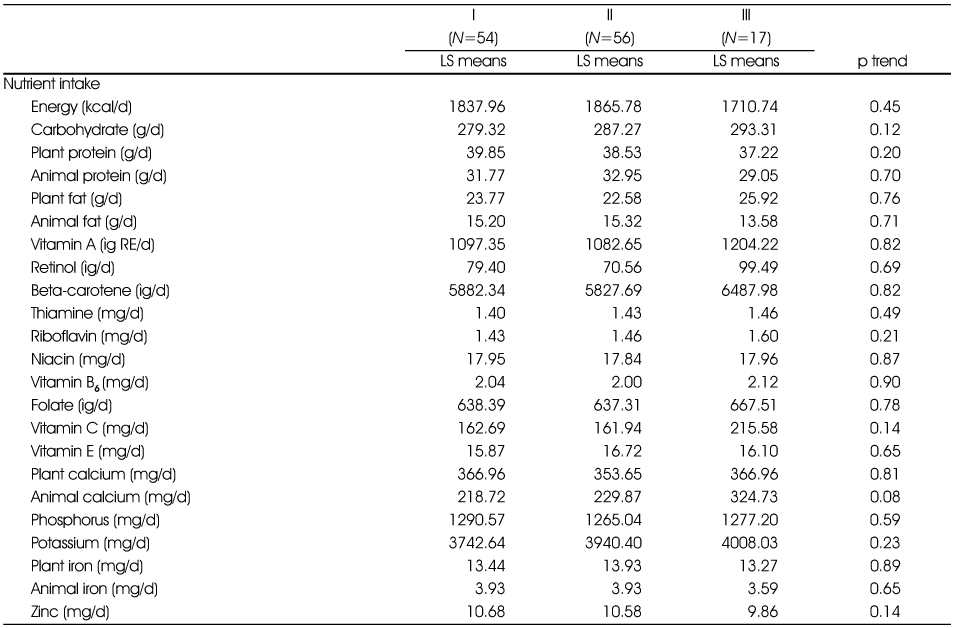
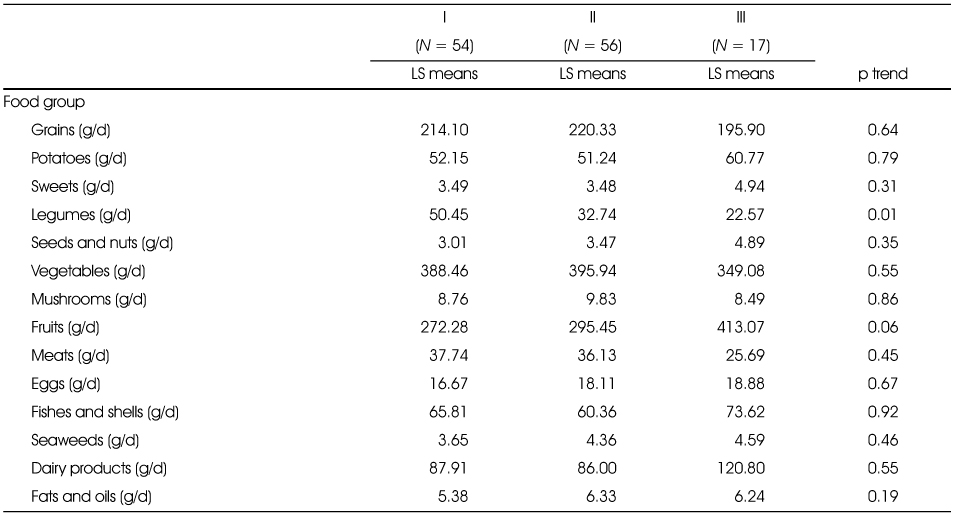
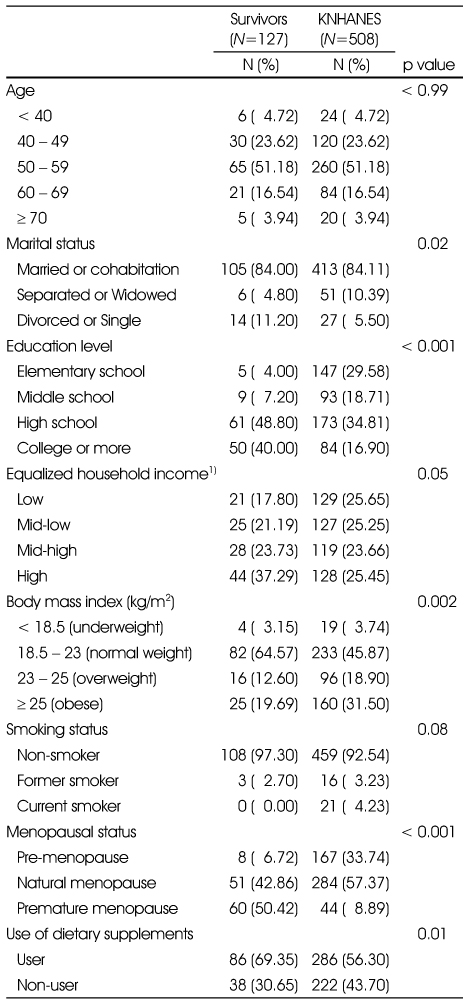
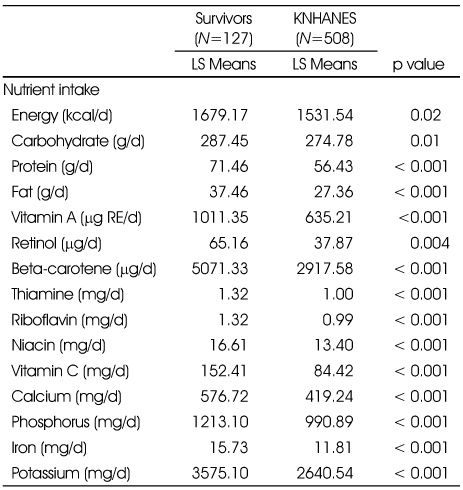
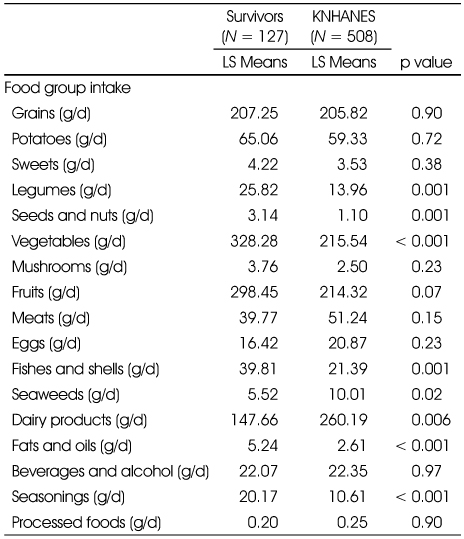
 Cite
Cite


